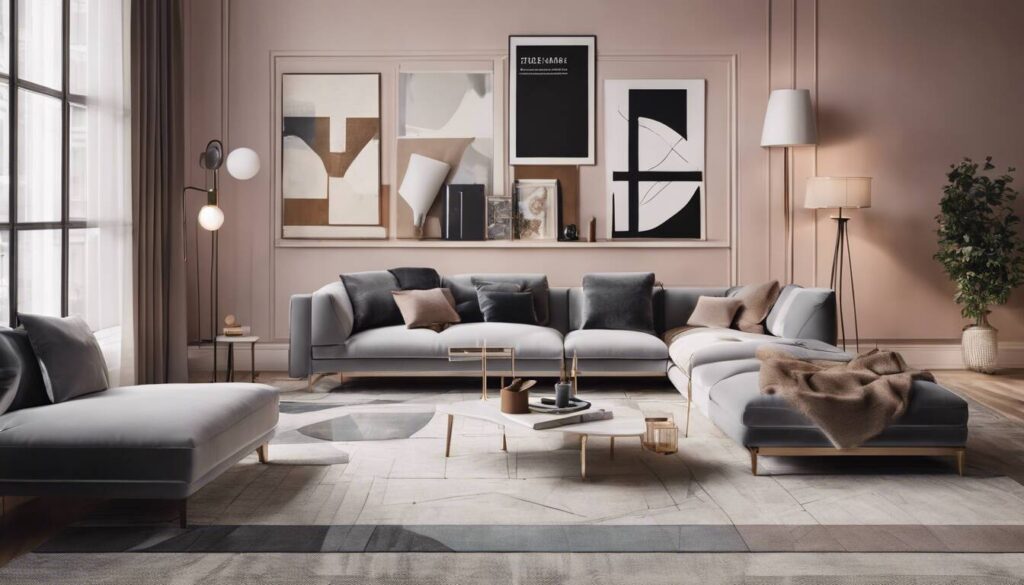Measuring success with your interior design PR involves tracking definable impacts like an uptick in media visibility and website traffic. These impacts provide evidence that your public relations efforts are indeed worth investing in. Yet, these metrics don’t tell the whole story – it’s also about realizing a growth in potential client interactions facilitated by your PR actions. Now, setting clear business and PR goals, brings everything into sharp focus.
You can measure the success of your interior design PR efforts by tracking media coverage in target publications, monitoring reach and engagement on social media, assessing an increase in inquiries and client engagements, and observing changes in website traffic and social media metrics after coverage. These metrics will help gauge the impact and effectiveness of your PR campaigns.

Identifying Measurable Success in Interior Design PR
In the world of interior design, PR isn’t just about getting your name mentioned here and there; it’s about ensuring that the right people are learning about you and, more significantly, that those people are turning into actual clients. When we discuss measurable success in this field, we’re looking at numbers and outcomes that demonstrate our effectiveness – businesses hearing about you and expressing interest in your work.
One major indicator for successful interior design PR is increased media presence in relevant design publications. When reputable magazines and websites feature your projects, it’s like having a spotlight shining on your work. Tracking how often you’re featured can give you an idea of how much attention your work is getting.
Another important metric to consider is website traffic. When your projects get covered in the media or when you share them on social media, do more people visit your website afterward?
Let’s put it into perspective: Imagine being an interior designer with a website showcasing your previous projects and sharing your design philosophy. Now, let’s say a prominent industry blog wrote an article featuring one of your recent designs, linking back to your website. After that article was published, within 24 hours, the number of visits to your website spiked up by three times compared to the average daily visitors before the publication. This indicates strong interest from potential clients seeking more information about your work after reading the article.
Notably, growth in social media engagement serves as another measure of success. When people start following, commenting on, and sharing images of your designs on social platforms, it shows that they’re drawn to what you create. It’s not just about likes or shares – those engagements represent real people forming a connection with your work.
Ultimately, an uptick in client inquiries and conversions catalyzed by PR activities is the culmination of all these efforts. A successful PR campaign should lead to potential clients reaching out to learn more or even hiring you for their own projects.
By carefully measuring these quantifiable metrics—media presence, website traffic, social media engagement, client inquiries, and conversions—interior designers can gauge the impact and effectiveness of their PR campaigns. It’s not just about creating noise; it’s about generating real interest and connections that lead to tangible results for a thriving business.
Defining Crucial Business and PR Goals
Setting clear and specific business and PR goals is akin to charting a roadmap for your firm’s growth and reputation. Let’s closely examine what these goals might entail and why they are indispensable.
Enhancing Brand Visibility: This may involve bolstering the visibility of your interior design firm across various platforms and media channels. Whether it’s through online publications, social media platforms, or industry events, improving brand visibility can help establish your firm as a recognizable and respected player in the interior design space.
Securing Media Coverage: Imagine seeing your work or expertise featured in leading design publications—this type of exposure can significantly elevate your firm’s profile. It can not only attract potential clients but also enhance your credibility within the industry.
Positioning as Industry Thought Leader: This involves establishing your firm as an authority in the field of interior design. Attaining this position means that your insights and expertise are valued and sought after. It can lead to speaking engagements, collaborations, and partnerships that further solidify your firm’s reputation as a thought leader.
Attracting Potential Clients: Ultimately, all these PR efforts must lead to attracting potential clients. Generating leads and inquiries from individuals or organizations seeking your services is a tangible measure of success.
Aligning these business and PR goals with specific activities ensures that every effort contributes to achieving these benchmarks. It provides clarity, focus, and purpose to the various PR strategies implemented.
Understanding the importance of setting clear business and PR goals is fundamental to assessing the effectiveness of PR efforts, as it allows for targeted measurement against established objectives. These goals provide a yardstick by which the success of PR activities can be evaluated, helping firms gauge their progress and make informed decisions about future PR initiatives.
Utilising Data for Result Analysis
Gone are the days of relying solely on intuition or general impressions to understand if your interior design PR strategies have been effective. The beauty of our digital world is that it provides us with a wealth of data that can help us gauge the impact of our efforts.
Imagine if you could know exactly how many people visited your website after a press release, or how many potential clients engaged with your social media content – well, you can! These metrics are like pieces of a puzzle that, when put together, paint a clear picture of how successful your PR strategies have been.
Let’s say you recently launched a new campaign to promote an innovative design project. By utilizing data analytics tools like Google Analytics and social media insights, you can track the increase in website traffic immediately after the release. This would give you a better idea of the campaign’s reach and the level of interest it generated.
It’s not just about numbers, though. It’s about what they represent. Take conversion rates from PR-driven leads, for example. By tracking these conversions through customer relationship management (CRM) systems, you can understand how many leads translated into actual business opportunities as a result of your PR efforts.
Quantitative insights from data analytics tools and CRM systems provide tangible evidence of the impact of PR activities on actual business outcomes. For instance, by analyzing conversion rates and client acquisition costs, you gain a clear understanding of the effectiveness and efficiency of your PR strategies.
By digging deep into these metrics, you’re not just looking at numbers; you’re gaining valuable insights into what worked and what didn’t. This allows you to refine your strategies over time based on factual evidence rather than guesses.
So, it’s clear that data isn’t just something to be collected and forgotten about; it’s a valuable tool that shapes future decisions—the key to evolving and improving your interior design PR strategies.
Monitoring Media Coverage and Social Media Results
When evaluating the impact of interior design PR efforts, monitoring media coverage and social media results play a crucial role. Media coverage tracking involves quantifying the number of press releases, features, and mentions secured in desired design publications. This step is essential to gauge the effectiveness of PR campaigns and to understand the reach and visibility achieved within the target audience.
Measuring media coverage provides valuable insights into how well the PR strategy is resonating with the intended audience. It allows for an assessment of the frequency and quality of media placements, enabling PR professionals to refine their approach based on which types of content and placements drive the most engagement and interest.
Utilizing PR Software for Monitoring
PR software tools such as Cision and Meltwater are commonly utilized to streamline the monitoring process. These platforms provide comprehensive dashboards that offer real-time insights into media mentions, reach, and sentiment analysis. By leveraging such tools, interior design PR professionals can gain a holistic view of their media coverage landscape, allowing them to make data-driven decisions for future campaigns.
Additionally, these PR software tools enable the tracking of key metrics such as share of voice, which compares an interior design brand’s media presence against its competitors. This competitive insight is invaluable in understanding where the brand stands in relation to industry peers.
In parallel with monitoring media coverage, interior design PR efforts necessitate a focus on measuring social media results. This entails quantifying the growth in followers, likes, shares, and comments attributed to PR-driven content across various social platforms.
By analyzing social media metrics before, during, and after PR initiatives, PR professionals can gauge the impact of their efforts on audience engagement and brand visibility. Key metrics include changes in follower count, post engagement rates, and share of voice relative to industry competitors.
Leveraging Social Media Management Tools
Tools like Hootsuite and Sprout Social offer robust analytics functionalities that allow PR professionals to track social media performance comprehensively. These platforms provide detailed reports on audience demographics, post reach, and engagement trends, empowering interior design PR teams to refine their social media strategies based on actionable data insights.
Embracing modern data-driven approaches through PR software and social media management tools is essential in effectively evaluating the success of interior design PR strategies. The ability to track media coverage and social media results not only provides quantifiable metrics but also informs strategic decision-making for future campaigns.
Tried and Tested Strategies for Success Measurement
Success in interior design PR isn’t just about garnering attention—it’s about engaging the right audience and converting that attention into meaningful action. To effectively measure the impact of PR efforts, it’s crucial to implement targeted strategies that provide actionable data. One such strategy is A/B testing PR campaign elements.
A/B testing involves creating two versions of a PR message or content piece, such as a press release or social media post, with one differing element. This could be the headline, call-to-action, or even the visual content. By observing which version performs better in terms of engagement, click-through rates, or lead conversions, interior design PR professionals can gain valuable insights into what resonates best with their audience.
Additionally, utilizing UTM parameters enables tracking website traffic specifically from PR sources. UTM parameters are short text codes added to URLs in order to track the performance of campaigns and content. By incorporating these parameters into PR-related links, designers can accurately measure the traffic coming from their PR activities and determine the impact on website visits and user behavior.
Furthermore, conversion tracking plays a pivotal role in evaluating how effective PR efforts are in generating leads and driving actual business outcomes. By setting up conversion tracking for PR-driven leads—such as inquiries or sign-ups—designers can attribute specific conversions to their PR activities and gauge the return on investment more accurately.
These tried and tested strategies foster a systematic approach to gauging the impact of interior design PR efforts. They provide tangible data that goes beyond mere visibility metrics, allowing for a more comprehensive assessment of how PR initiatives contribute to achieving broader business goals.
Now equipped with strategies for measuring success, it’s time to shift our focus to evaluating client satisfaction and goal achievement in interior design PR.
Evaluating Client Satisfaction and Goal Achievement

One of the most critical aspects of interior design PR is ensuring that clients are not just satisfied, but their goals are also met. It’s not just about how attractive a campaign looks in print or online—it’s about making a real impact on the client’s business and perception in the industry.
To gauge client satisfaction, it’s essential to gather feedback directly from the clients. This can take many forms, such as surveys, interviews, or regular check-in meetings. By seeking direct input from clients, PR agencies can gain valuable insights into how their efforts have shaped the client’s brand narrative and reputation within the industry.
For example, a well-executed PR campaign may lead to increased recognition of the designer’s brand, positive media coverage in reputable design publications, and heightened visibility within the target market. Conversely, if a client feels their brand narrative has been misaligned or misrepresented, it can have a detrimental impact on client satisfaction and overall PR effectiveness.
Moreover, assessing goal achievement is paramount. Interior design PR campaigns should be designed with clear, measurable objectives in mind, such as increasing brand visibility, attracting potential clients, or positioning the designer as a thought leader in the field. By tracking these predefined objectives over time, PR agencies can ensure that their activities are resonating with the target audience and ultimately driving business growth for their clients.
For instance, if a central goal was to secure media placements in leading design publications, the number of secured features can serve as a tangible metric for goal achievement. Similarly, if the objective was to enhance digital presence through engaging content and social media campaigns, metrics such as website traffic growth and social media engagement can be used to evaluate success.
By meticulously evaluating both client satisfaction and goal achievement against predefined objectives, interior design PR agencies can refine their strategies, align their activities with client expectations, and ultimately drive meaningful impact for their clients within the competitive landscape of interior design.
Evaluating the impact of PR efforts isn’t just about tracking numbers; it’s about shaping a brand’s narrative and fostering meaningful connections with the target audience. With this understanding in mind, let’s now shift our focus to explore how PR plays an integral role in upholding an interior design firm’s reputation.
Upholding your Firm’s Reputation via PR
Building and maintaining a positive reputation in the interior design industry is crucial for the long-term success of your firm. Public Relations (PR) plays a pivotal role in this aspect by enabling consistent communication of your design philosophy, showcasing innovative projects, and positioning your firm as a thought leader in the industry.
Maintaining consistency is essential to successfully upholding your firm’s reputation through PR. By strategically aligning your PR activities with your brand values and aesthetic, you can build trust and credibility within the industry. Whether it’s through press releases, media engagements, or social media campaigns, every piece of content shared should reflect your firm’s unique perspective and commitment to excellence.
Furthermore, featuring successful projects and initiatives through PR channels not only enhances your visibility but also serves as a testament to the quality of work your firm delivers. Showcasing success stories and testimonials from satisfied clients can significantly influence potential clients’ trust in your capabilities and consideration of working with you.
For instance, featuring before-and-after transformations of spaces, sharing behind-the-scenes insights into the design process, or highlighting collaborations with renowned artists or architects can captivate audiences and demonstrate the depth of your firm’s expertise.
Crafting compelling narratives around your projects and design journey helps shape a positive perception of your firm in the eyes of both industry peers and potential clients. When executed effectively, it positions your firm as an authority in the field, drawing attention to your unique approach and establishing a solid reputation over time.
It’s essential to integrate storytelling into your PR strategy, using it as a tool to convey the passion, dedication, and vision that drive your firm’s design ethos. This humanizes your brand, making it more relatable and engaging for your target audience.
In summary, strategic PR activities aimed at consistently communicating your design philosophy and showcasing successful projects contribute significantly to maintaining a positive reputation in the interior design industry.
The art of PR in interior design is about more than just promotion; it’s about crafting compelling stories that authentically represent the values and expertise of your firm. A well-executed PR strategy can truly elevate the reputation of an interior design firm within the industry.

